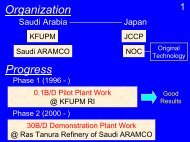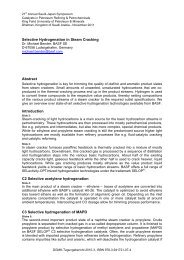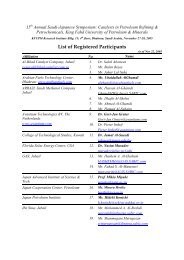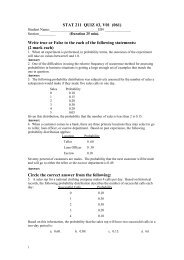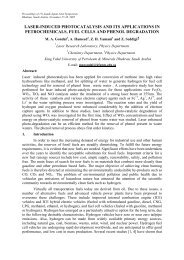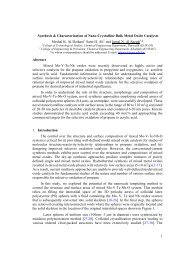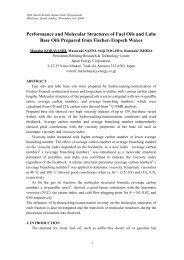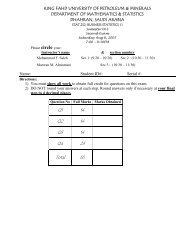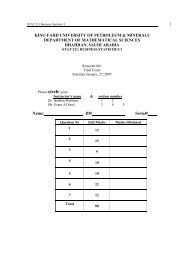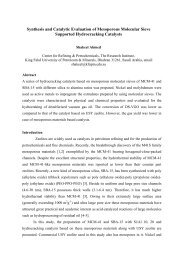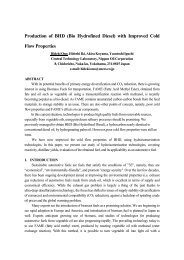You also want an ePaper? Increase the reach of your titles
YUMPU automatically turns print PDFs into web optimized ePapers that Google loves.
Objectives• To share with you how <strong>Saudi</strong> <strong>Aramco</strong> manages catalystselection in refineries• To present a case study for catalyst selection at the JiddahRefinery Fluid Catalytic Cracking Unit
Outline• Objective• <strong>Saudi</strong> <strong>Aramco</strong> (SA) <strong>Overview</strong>• <strong>Saudi</strong> <strong>Aramco</strong> Refining Sector• Importance of Catalyst Selection• <strong>Saudi</strong> <strong>Aramco</strong> Catalyst Protocol (SAES-A-207)• Case Study: Jiddah Refinery/FCC Catalyst selection• Catalyst Proposal Evaluation• Case Study Conclusion• Q&A
<strong>Saudi</strong> <strong>Aramco</strong> <strong>Overview</strong>• Owned by the <strong>Saudi</strong> Arabian Government• A fully-integrated, global petroleum enterprise and a world leaderin exploration and producing, refining, distribution, shipping andmarketing• Manages proven reserves of 260 billion barrels of oil (nearly aquarter of the world's total) the largest of any company in theworld, and manages the fourth-largest gas reserves in the world• Owns and operates the world's second largest tanker fleet to helptransport its crude oil production, which amounted to 3.3 billionbarrels in 2005• Has affiliates, joint ventures and subsidiary offices in China,Japan, Netherlands, Philippines, Republic of Korea, Singapore,United Arab Emirates, United Kingdom and the United States
<strong>Saudi</strong> <strong>Aramco</strong> International HeadquartersDhahran, <strong>Saudi</strong> Arabia
Outline• Objective• <strong>Saudi</strong> <strong>Aramco</strong> <strong>Overview</strong>• <strong>Saudi</strong> <strong>Aramco</strong> Refining Sector• Importance of Catalyst Selection• <strong>Saudi</strong> <strong>Aramco</strong> Catalyst Protocol (SAES-A-207)• Case Study: Jiddah Refinery/FCC Catalyst selection• Catalyst Proposal Evaluation• Case Study Conclusion• Q&A
<strong>Saudi</strong> <strong>Aramco</strong> Refining Sector• Total Capacity: 3 million barrels per day• Five domestic refineries• Interest in three domestic joint venture refineries with:• ExxonMobil; Shell; Sumitomo• Planned three domestic joint refinery projects with:• Total; ConocoPhillips; Dow• Interest in five international joint ventures:• Motiva Enterprises (USA)• S-Oil (S. Korea)• Petron (Philippines)• Showa Shell (Japan)
Refineries Geographical DistributionJubailYanbu’Ras TanuraRabighRiyadhJiddah5 Local Refineries2 J/V Refineries
Outline• Objective• <strong>Saudi</strong> <strong>Aramco</strong> <strong>Overview</strong>• <strong>Saudi</strong> <strong>Aramco</strong> Refining Sector• Importance of Catalyst Selection• <strong>Saudi</strong> <strong>Aramco</strong> Catalyst Protocol (SAES-A-207)• Case Study: Jiddah Refinery/FCC Catalyst selection• Catalyst Proposal Evaluation• Case Study Conclusion• Q&A
Why is a Catalyst Selection ProtocolNeeded?• Refining Catalyst (RC) is a big “chemical” purchase for arefinery• RC performance is a key contributor to refinery profitability• RCs have to be assessed as a high technology productsand not as a commodity• Selecting the wrong catalyst can be very costly and mayresult in operating problems• Minimizing catalyst inventories and optimizing the catalystutilization
Outline• Objective• <strong>Saudi</strong> <strong>Aramco</strong> <strong>Overview</strong>• <strong>Saudi</strong> <strong>Aramco</strong> Refining Sector• Importance of Catalyst Selection• <strong>Saudi</strong> <strong>Aramco</strong> Catalyst Protocol (SAES-A-207)• Case Study: Jiddah Refinery/FCC Catalyst selection• Catalyst Proposal Evaluation• Case Study Conclusion• Q&A
Objective of <strong>Saudi</strong> <strong>Aramco</strong> Catalyst Selection& Replacement Standard (SAES-A-207)To implement a programthat results in thecost-effectivemanagement ofcatalysts anddesiccants for thecompany
SA Standard for Catalyst SelectionProtocols• Generate Technical Package and Performance Guarantee• Solicit Proposals from Vendors• Proposal Evaluation• Pilot Plant Testing• Users Survey• Economic Evaluation• Recommendation• QA/QC of Pre-delivery sample• Performance Test
Steps for General Catalyst SelectionUnitOperationDataData GatheringRefineryObjectivesUnitLimitationsCatalyst ProposalsPhysical &ChemicalPropertiesVenderProjectionConsistencyCheckNo P/PPotentialCatalystSelectionPilot Plant (P/P)TestEvaluate Resultsof P/PEconomical Evaluationon TechnicallyAcceptable CatalystSystemsCatalyst Selection& Recommendations
Outline• Objective• <strong>Saudi</strong> <strong>Aramco</strong> <strong>Overview</strong>• <strong>Saudi</strong> <strong>Aramco</strong> Refining Sector• Importance of Catalyst Selection• <strong>Saudi</strong> <strong>Aramco</strong> Catalyst Protocol (SAES-A-207)• Case Study: Jiddah Refinery/FCC Catalyst selection• Catalyst Proposal Evaluation• Case Study Conclusion• Q&A
FCC Background• FCC is a process that cracks heavy oil to value-added productsusing powdered catalyst• FCC has been refinery workhorse for gasoline production since55 years (around 45% of all gasoline comes from FCC)• Around 400 FCC units worldwide with a capacity of 14.2 millionbbl/d (avg. unit is 35,000 bbl/d)• Leading FCC catalyst producers are Albermarle, Engelhard(BASF), CCIC and Grace• Major Process licensors: UOP, Exxon, KBR, Shell, S&W/IFP,ABB
FCC Typical Process Flow DescriptionAtmosphereReactor Vapor LineOrificeChamberREACTORL. NaphthaLPG &GasesREGENERATORHeavyNaphthaStrippingSteamMainColumnLCORISERSlide ValvesFeedInjectorsCir.HCOAir HeaterAir FromAir BlowerLiftingSteamHeaterRaw OilCSO
JRD Typical Feedstock PropertiesFeed Rate, MBPD 20Feed Stock Gas Oil (240 – 630 o C)API gravity @ 60F 23.25Specific gravity @ 60F 0.91Sulfur wt % 2.6Total Nitrogen ppm 630Basic Nitrogen ppm 155Conradson Carbon wt % 0.24Ni ppm < 1V ppm < 1Refractive index 1.52Viscosity cSt 26
Operating Conditions• Combined Feed T, o C 235• ROT, o C 514• Flue Gas T, o C 736• Reg. Dilute Phase, o C 689• Cat. Circulation, ton/min 16• Catalyst addition rate, TPD 1.0
Outline• Objective• <strong>Saudi</strong> <strong>Aramco</strong> <strong>Overview</strong>• <strong>Saudi</strong> <strong>Aramco</strong> Refining Sector• Importance of Catalyst Selection• <strong>Saudi</strong> <strong>Aramco</strong> Catalyst Protocol (SAES-A-207)• Case Study: Jiddah Refinery/FCC Catalyst selection• Catalyst Proposal Evaluation• Case Study Conclusion• Q&A
Catalyst Proposal Evaluation• Four technical proposals received from catalyst vendors• Selection Criteria For JRD/FCCU Catalyst:• Octane Number• Gasoline sulfur content• Gasoline yield• Technical support• Consistency of the vendor projection with Laboratory Tests• Economical Analysis
Vendor Projections (Delta Yields)Δ Yield %PRODUCT (v.%)BASECatalyst Catalyst A Catalyst BCatalystC1 C2Fuel Gas (C 2- ) (FOE) 4.33 0 - 0.23 - 0.07 - 0.04LPG (C 3 -C 4 ) 14.0 2.54 0.33 - 0.25 1.62Gasoline (C 5 - 430 F) 57.80 0.38 2.49 1.03 0.16Light Cycle Oil 14.95 - 0.74 - 0.3 - 0.36 - 0.73Heavy Cycle Oil + Slurry 13.90 - 1.05 - 1.53 - 0.25 - 0.30
Vendor – Product QualitiesProduct QualityBaseCatalyst CCatalystA Catalyst B Catalyst C1 Catalyst C2Δ RONC 900.85 0.27 0.07 0.25Δ S (wt.%) 0.3 - 0.001 - 0.031 - 0.006 - 0.006
Laboratory Catalyst Testing• Physical Properties• Stability – Fresh, and two steaming conditions• Microactivity Test (MAT) – Selectivity• Octane
MAT ResultsProduct QualityBaseCatalystACatalyst CCatalystB Catalyst C1 Catalyst C2Fuel Gas (C 2- )(FOE) 2.23 2.32 2.48 2.17 2.05LPG (C 3 -C 4 ) 17.85 18.15 19.63 17.65 16.6Gasoline (C 5 -430F) 54.4 55.52 54.4 55.38 55.65LCO 15.2 14.45 12.85 15.45 16.4HCO 6.6 5.95 5.67 6.42 6.2Coke 3.8 3.73 4.18 3.07 3.2RONC 88.8 87.03 89 88.55 86.85S (ppm) 615 640 650 560 668
Selection AnalysisCatalyst A‣ Large Increase In LPG‣ Second Most Expensive‣ Projected Increased Gasoline RON Not Supported By MATCatalyst B‣ Large Increase In Gasoline‣ Most Expensive‣ Projected Gasoline Volume Increase Not Supported By MATCatalyst C1‣ Large Increase In Gasoline‣ MAT testing supports vendors projection for Gasoline yield andRON.Catalyst C2‣ Large Increase In LPG
Outline• Objective• <strong>Saudi</strong> <strong>Aramco</strong> <strong>Overview</strong>• <strong>Saudi</strong> <strong>Aramco</strong> Refining Sector• Importance of Catalyst Selection• <strong>Saudi</strong> <strong>Aramco</strong> Catalyst Protocol (SAES-A-207)• Case Study: Jiddah Refinery/FCC Catalyst selection• Catalyst Proposal Evaluation• Case Study Conclusion• Q&A
Case Study Conclusion• Four technical proposals received from catalyst vendors• Extensive MAT tests were conducted to evaluate and validatethe performance of the proposed catalysts• The catalysts were ranked according to the refinery criteria• Catalyst C1 was recommended due to its high RON,and highgasoline yield with low sulfur content• The estimated annual benefit to the Jiddah refinery was overaround 1.4 million/year
Catalyst Management Protocols in <strong>Saudi</strong><strong>Aramco</strong>Case Study: Fluid Catalytic Cracking Catalyst SelectionThank YouQ/A
<strong>Saudi</strong> <strong>Aramco</strong> Jiddah Refinery



